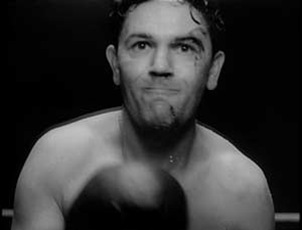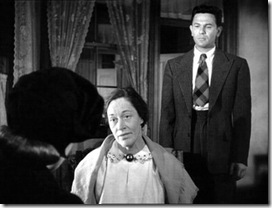1947
Director Robert Rossen
A boxer dies from a brain haemorrhage. A simple fact is reinforced throughout the gritty  Body and Soul: boxing is brutal; a sport that juxtaposes all of the competitive honour, pride and glory of single battle with the pointlessness of death, the corruption of wealth, and the evils of fame.
Body and Soul: boxing is brutal; a sport that juxtaposes all of the competitive honour, pride and glory of single battle with the pointlessness of death, the corruption of wealth, and the evils of fame.
The story is fairly routine. Working class New Yorker, Charlie Davis is a skilled fighter who wants desperately to succeed. He falls for the beautiful and talented artist Peg, whom he wants to marry and support. Unfortunately for Charlie, the death of his father causes him a great deal of guilt, which he tries to exorcise by doing everything his dear old Ma asks of him. The problem is, she’s not the biggest boxing fan. It takes the bailiffs to drive Charlie back into the murky world of prize-fighting, where money grabbing sharks like Lloyd Gough’s Roberts and William Conrad’s Quinn steal him away from his loyal friend and manager, Joseph Pevney’s engrossing Shorty. Charlie is blinded by wealth and fame with predictably tragic consequences.
Robert Rossen is successful in representing the contrast of emotions in boxing in his 1947 drama. There are few scenes more tragic than the death of Canada Lee’s quietly engaging Ben Chaplin. Betrayed, abandoned, the only career and life he ever knew now lost, he is left swinging blindly in a training ring, desperate to recapture his glory days, refusing to give in to the preying vultures of organised crime, before finally falling down dead. Just before this heart-breaking moment, Ben speaks with such gusto and enthusiasm to Charlie on what tactics he (Charlie) should employ to defeat the young upstart Marlowe. The passion and love which Ben still holds for the sport of boxing is a magnificent example of everything that is good about the violent dance. But what follows shortly after quickly highlights the darker side of the squared circle.
 It just so happens that this reviewer has a great love for the sport of boxing. The in-ring scenes towards the end when Charlie is quite literally fighting for his life against Marlowe almost feel like a punch in the gut themselves, as James Wong Howe’s cinematography takes you about as close as you can get without drawing blood. Boxing is the most visceral of sports and these scenes, though relatively few, are jaw-breakingly effective. It is not hard to believe that men die in the ring when you see Charlie staggering and swaying, his face the proverbial crimson mask, mere inches away from your own. Cinema is a visceral pastime itself, and Rossen’s ability to make this connection between the two worlds is a real achievement.
It just so happens that this reviewer has a great love for the sport of boxing. The in-ring scenes towards the end when Charlie is quite literally fighting for his life against Marlowe almost feel like a punch in the gut themselves, as James Wong Howe’s cinematography takes you about as close as you can get without drawing blood. Boxing is the most visceral of sports and these scenes, though relatively few, are jaw-breakingly effective. It is not hard to believe that men die in the ring when you see Charlie staggering and swaying, his face the proverbial crimson mask, mere inches away from your own. Cinema is a visceral pastime itself, and Rossen’s ability to make this connection between the two worlds is a real achievement.
Like a prologue to Elia Kazan’s 1954 On The Waterfront, Body and Soul expertly captures the working class society which still surrounds the sport of boxing to this day. With Kazan’s piece, we have Terry Malloy. Both Terry and Charlie are poorly educated, good natured, honest, hard-working men who are unlucky enough to find themselves caught up in a time of great economic strife in America. It is their lack of education which makes them vulnerable to the predatory crooks of Capitalism, hoodlums with the money to seduce and corrupt these men who just want to provide for their families. Both On The Waterfront’s Marlon Brando and Body and Soul’s John Garfield excel in their performances as hardened, gritty men who only know how to do one thing good and that’s fight. But whilst Brando relied of his superb naturalism to make us believe he was a fighter, Garfield genuinely has taken quite a few lickings in his day, and his cauliflower ears and broken nose just bring the wonderful Charlie to life. His smile is one of the most heart-warming features of the film, peering out from behind the bruises and the confusion, drawing us in willingly to this loveable rogue with open arms.
It is not necessary to be a fan of boxing to enjoy Rossen’s drama. The themes running throughout are not the property of boxing pictures alone, or even the sports subgenre. Greed, ambition, betrayal, corruption: stop me if you think you have heard any of these before! As Christopher Marlowe will tell you, selling your soul to the Devil is not exactly a new story. Don’t dismiss this film based on its boxing content. If you are not a fan of this sport, not to worry; Rossen’s powerful piece just uses the sport of boxing as the vehicle for his narrative. Kazan tells almost the exact same tale without ever showing a fight. He deals with the aftermath of a fighter’s career, and it is ominous to think that such a life perhaps awaits the unfortunate Charlie.
throughout are not the property of boxing pictures alone, or even the sports subgenre. Greed, ambition, betrayal, corruption: stop me if you think you have heard any of these before! As Christopher Marlowe will tell you, selling your soul to the Devil is not exactly a new story. Don’t dismiss this film based on its boxing content. If you are not a fan of this sport, not to worry; Rossen’s powerful piece just uses the sport of boxing as the vehicle for his narrative. Kazan tells almost the exact same tale without ever showing a fight. He deals with the aftermath of a fighter’s career, and it is ominous to think that such a life perhaps awaits the unfortunate Charlie.
You might be excused for overlooking Body and Soul on the list of great boxing movies. After all, in the same century we were privileged enough to experience the likes of Raging Bull and Rocky, both of which have achieved far more commercial and academy acclaim. But watching Rossen’s piece is special for that very reason; it feels as though you are watching the future. The hauntingly violent and beautiful choreography used by Rossen in the boxing scenes is evidently employed by Martin Scorsese some thirty years later. When Charlie is ducking and weaving, his eyes swollen and nose broken, images of Robert De Niro as Jake La Motta constantly flash before your eyes. When Charlie runs from the ring, tears streaming down his face in a mixture of glee and misery, I was half expecting him to break into a cry of “ADRIAN!”
These familiarities cannot be overlooked. What have just been mentioned are two of the greatest sports films of all time and Body and Soul has quite clearly played a huge role in their development. Simply add this to the superb cast and flawless presentation, Robert Rossen’s picture deserves as much recognition as possible as a pioneer of its genre that stands up admirably to the test of time.
**** / *****
No comments:
Post a Comment